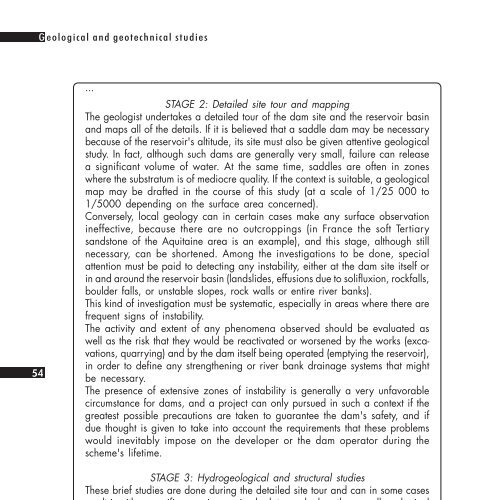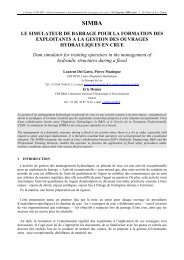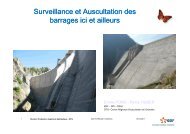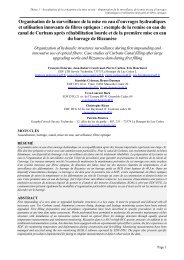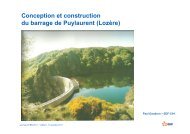SMALL DAMS
SMALL DAMS - Comité Français des Barrages et Réservoirs
SMALL DAMS - Comité Français des Barrages et Réservoirs
- No tags were found...
You also want an ePaper? Increase the reach of your titles
YUMPU automatically turns print PDFs into web optimized ePapers that Google loves.
G eological and geotechnical studies<br />
54<br />
...<br />
STAGE 2: Detailed site tour and mapping<br />
The geologist undertakes a detailed tour of the dam site and the reservoir basin<br />
and maps all of the details. If it is believed that a saddle dam may be necessary<br />
because of the reservoir's altitude, its site must also be given attentive geological<br />
study. In fact, although such dams are generally very small, failure can release<br />
a significant volume of water. At the same time, saddles are often in zones<br />
where the substratum is of mediocre quality. If the context is suitable, a geological<br />
map may be drafted in the course of this study (at a scale of 1/25 000 to<br />
1/5000 depending on the surface area concerned).<br />
Conversely, local geology can in certain cases make any surface observation<br />
ineffective, because there are no outcroppings (in France the soft Tertiary<br />
sandstone of the Aquitaine area is an example), and this stage, although still<br />
necessary, can be shortened. Among the investigations to be done, special<br />
attention must be paid to detecting any instability, either at the dam site itself or<br />
in and around the reservoir basin (landslides, effusions due to solifluxion, rockfalls,<br />
boulder falls, or unstable slopes, rock walls or entire river banks).<br />
This kind of investigation must be systematic, especially in areas where there are<br />
frequent signs of instability.<br />
The activity and extent of any phenomena observed should be evaluated as<br />
well as the risk that they would be reactivated or worsened by the works (excavations,<br />
quarrying) and by the dam itself being operated (emptying the reservoir),<br />
in order to define any strengthening or river bank drainage systems that might<br />
be necessary.<br />
The presence of extensive zones of instability is generally a very unfavorable<br />
circumstance for dams, and a project can only pursued in such a context if the<br />
greatest possible precautions are taken to guarantee the dam's safety, and if<br />
due thought is given to take into account the requirements that these problems<br />
would inevitably impose on the developer or the dam operator during the<br />
scheme's lifetime.<br />
STAGE 3: Hydrogeological and structural studies<br />
These brief studies are done during the detailed site tour and can in some cases<br />
result in either specific mapping or simply data marked on the overall geological<br />
map.<br />
!" brief hydrogeological study<br />
In this stage, the goal is to define the broad outlines of the hydrological conditions<br />
in the foundation of the dam and the corresponding reservoir basin, and<br />
their local context.<br />
Generally, this study involves an inventory of trial pits (collecting data such as<br />
water levels and variations in them, geological layers, operating discharge,<br />
etc.), springs, resurgences or losses.<br />
Depending on how dense the inventoried points are, an attempt can be made<br />
to sketch out the natural groundwater level in the dam area and deduce some<br />
preliminary ideas of its probable behaviour due to creation of a lake (if the<br />
water table on the river banks is higher than the level of the future reservoir,<br />
...


